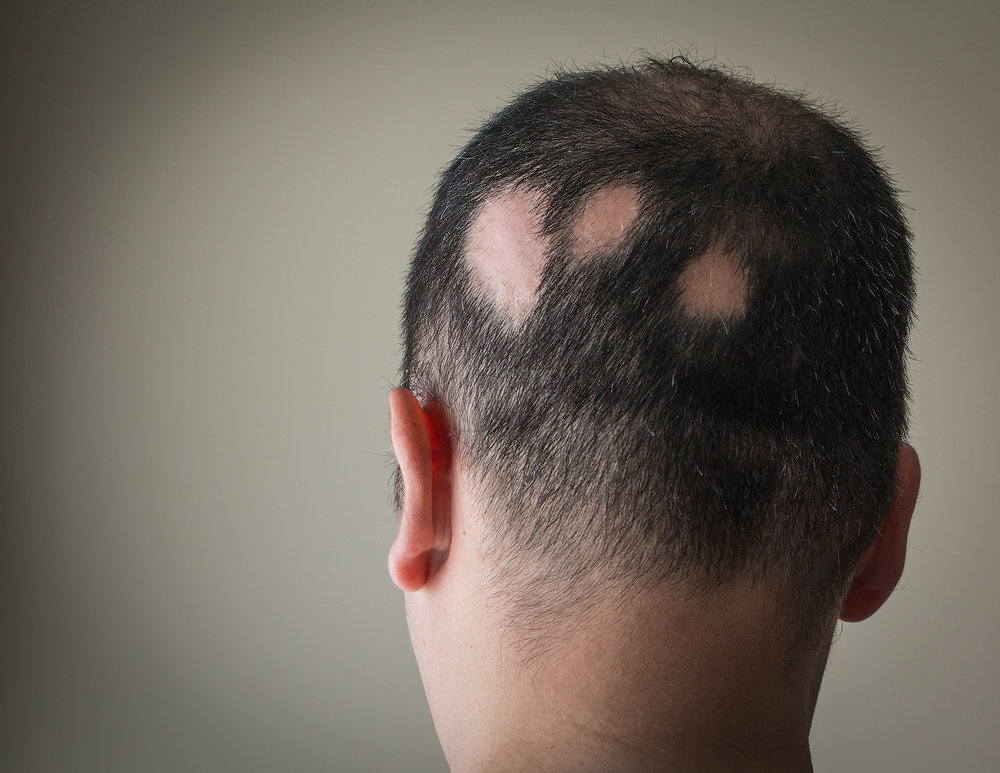
What Is Alopecia Areata?
Alopecia areata is a local baldness disease, meaning that a person is only bald in certain areas. These small areas of baldness will become more and more connected and cause complete baldness or alopecia totalis.
Alopecia areata usually affects the scalp. In some cases, local baldness can also occur on the eyebrows, eyelashes, face and other body parts. Alopecia areata can develop slowly and occur over years.
Every case of alopecia areata is different. Hair loss can occur in only a few areas, but there are also those who experience large amounts of hair loss in various areas of their body. A sufferer can experience total baldness on the scalp (alopecia totalis) or even on the whole body (alopecia universalis), but this condition rarely occurs.
What causes the condition Alopecia Areata?
Abnormalities that occur in the immune system are the cause of alopecia areata. This disorder causes the immune system to attack healthy cells like viruses and bacteria.
The immune system in alopecia areata sufferers will attack the hair follicles, where hair grows. Hair follicles will become smaller and over time they will not be able to produce hair again.
The researchers couldn't find a reason why the body's immune system attacks hair follicles. However, cases of alopecia areata often occur in someone who has a family background with immune system disorders such as diabetes and rheumatoid arthritis. This is what underlies the opinion of researchers that one of the causes of baldness is genetic or hereditary factors.

What are the symptoms of Alopecia Areata?
The main symptom of alopecia areata is baldness that occurs in certain areas of the body that have hair. Hair loss can start in very small areas that are not visible to the eye. Alopecia areata can also occur in areas other than the scalp, such as eyebrows, eyelashes, mustache, beard, hair on hands and feet.
You will experience a large amount of hair loss right after you wake up or when you shower, and over time the bald spots will form small areas (usually shaped like a circle). This area will enlarge and increase in number.
Alopecia areata cannot be diagnosed solely from the hair loss that a person is experiencing. Hair loss can occur for a variety of reasons apart from immune system disorders, such as a fungal infection (Tinea Capitis) and other psychiatric-related illnesses. Where the patient has a tendency to pull out his own hair (Trichotillomania).
In some cases, a person with alopecia areata can experience severe hair loss. This condition may indicate other types of alopecia, namely:
Alopecia totalis: Complete baldness of the scalp
Alopecia Universalis: Complete baldness of the entire body
A person may experience baldness in certain areas, but not in others. For example: Baldness occurs on the legs and head, but not on the arms.
How is Alopecia Areata diagnosed?
The doctor will do a scalp biopsy to find out other conditions that cause baldness such as fungal infections. A biopsy requires taking soft tissue for examination in the laboratory. In the case of a scalp biopsy, the doctor may take a sample of your scalp for analysis.
Blood tests will be done if the immune system is suspected as the cause of baldness. Your doctor will want to see if you have abnormal antibodies in your body, which if found, you most likely have an immune system disorder.
How to treat Alopecia Areata?
There isn't really a cure for alopecia areata, but there are some medical or natural treatments that can slow hair loss and help hair grow faster.
Medical treatment of Alopecia Araeta
You can apply the drug on the scalp and stimulate hair growth. Some ways to treat alopecia areata medically include:
Minoxidil is a topical alopecia areata drug that can be used as a way to treat hair loss. Minoxidil can prevent hair loss by applying it to the scalp and other areas that are experiencing hair loss. Minoxidil is a safe drug, but results can be seen for up to a year after regular use.
Corticosteroids Corticosteroids can come in various forms, such as ointments, tablets, and injections. Corticosteroids can reduce inflammation that occurs in hair follicles.
Anthralin Anthralin can cause irritation to the scalp which promotes hair growth.
Immunotherapy Immunotherapy is given to alopecia areata sufferers who experience hair loss and large amounts of hair loss. Some chemical substance will be applied on the scalp to give an allergic reaction. If successful, this allergic reaction can actually stimulate hair to grow back. Immunotherapy can cause itching and redness of the scalp. This therapy is usually ongoing for optimal results.
Alopecia Areata Treatment naturally
Apart from being medical, there are several ways to deal with baldness naturally. This is an alternative treatment for alopecia areata, most of the results of which cannot be proven clinically, some patients have managed to grow their hair back and some have not. Even though it uses natural ingredients, the side effects it produces on the body can have a negative impact. Before doing this natural alopecia areata treatment, please consult a doctor.
Some alternative ways to treat baldness naturally include:
- aroma therapy
- probiotics
- laser therapy
- vitamins: zinc and biotin
- aloe vera and other natural topical alopecia areata remedies
- essential oils: lavender, rosemary, and peppermint
- other oils: olive and coconut oil
- head massage
- herbal supplements: ginseng and green tea
Alopecia areata is not a dangerous disease, but it can affect the emotional side of the sufferer. Baldness can cause a person to feel insecure which can lead to depression. Recognizing the symptoms and how to treat baldness early can help prevent the severity of the alopecia areata you are experiencing.
Article reviewed by dr. Midi Haryani, Sp.KK, FINSDV, MM (Skin and Venereal Specialist at EMC Pulomas Hospital).
